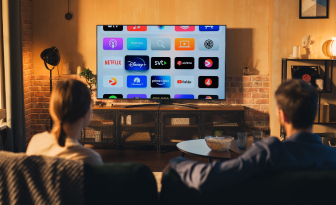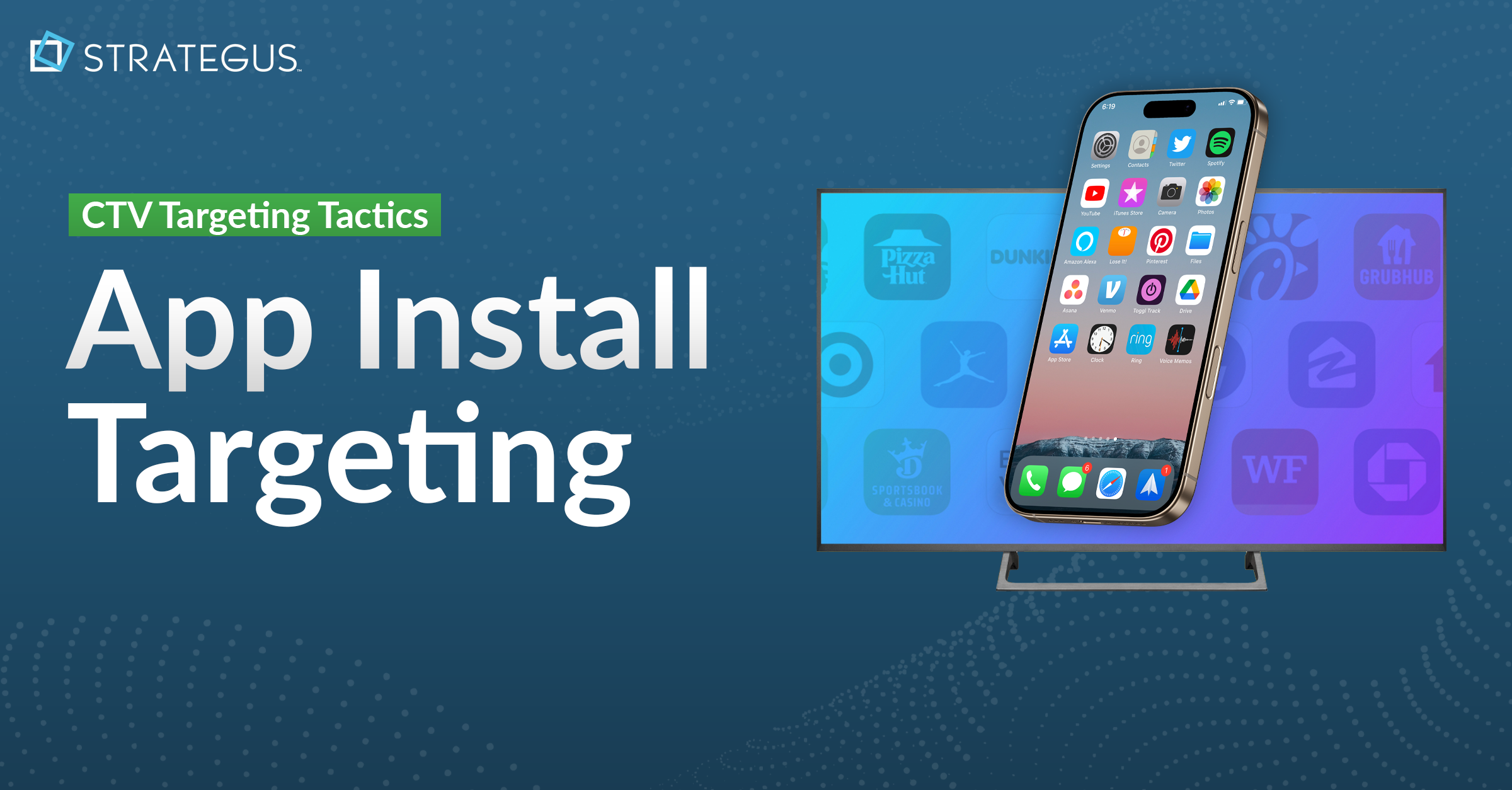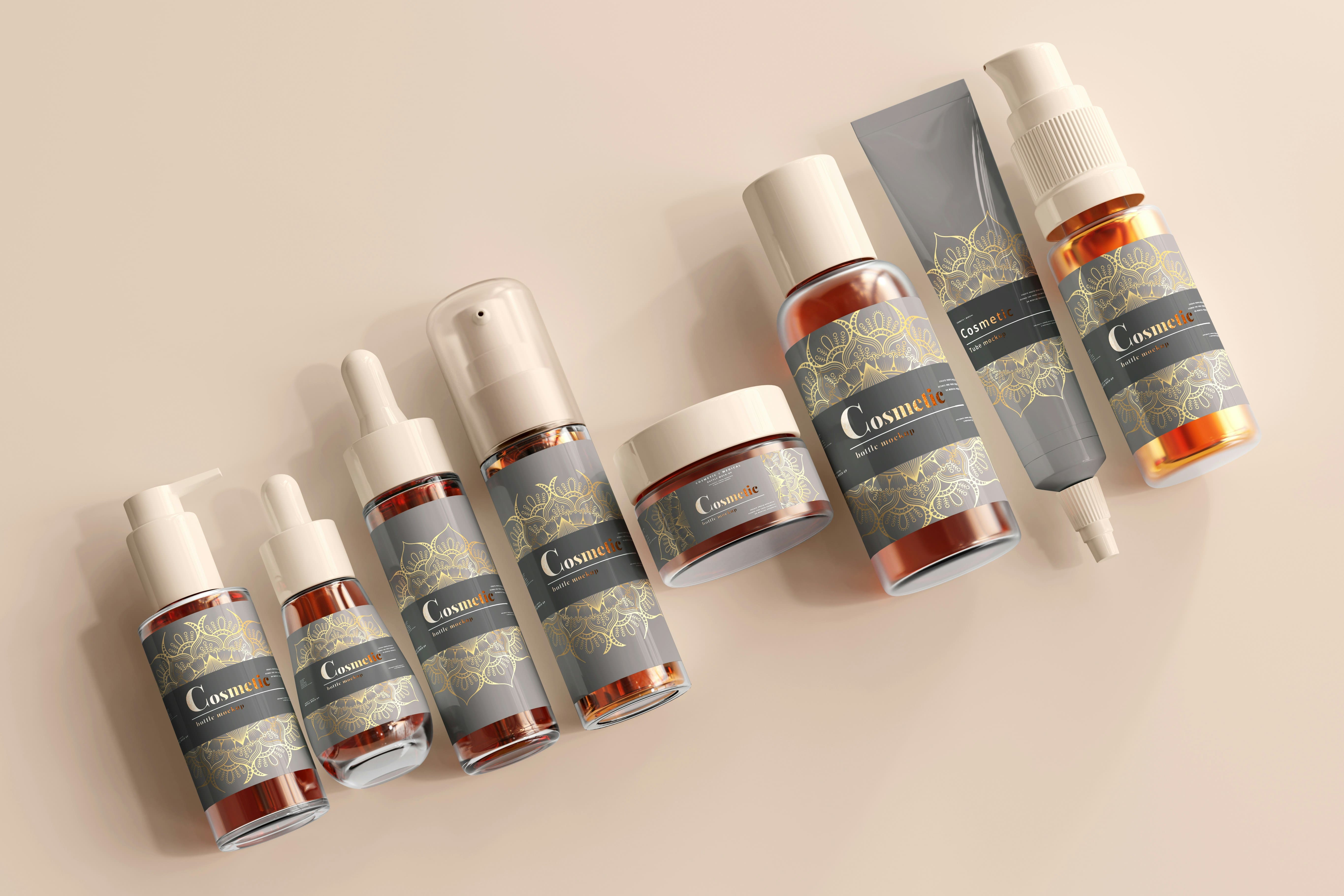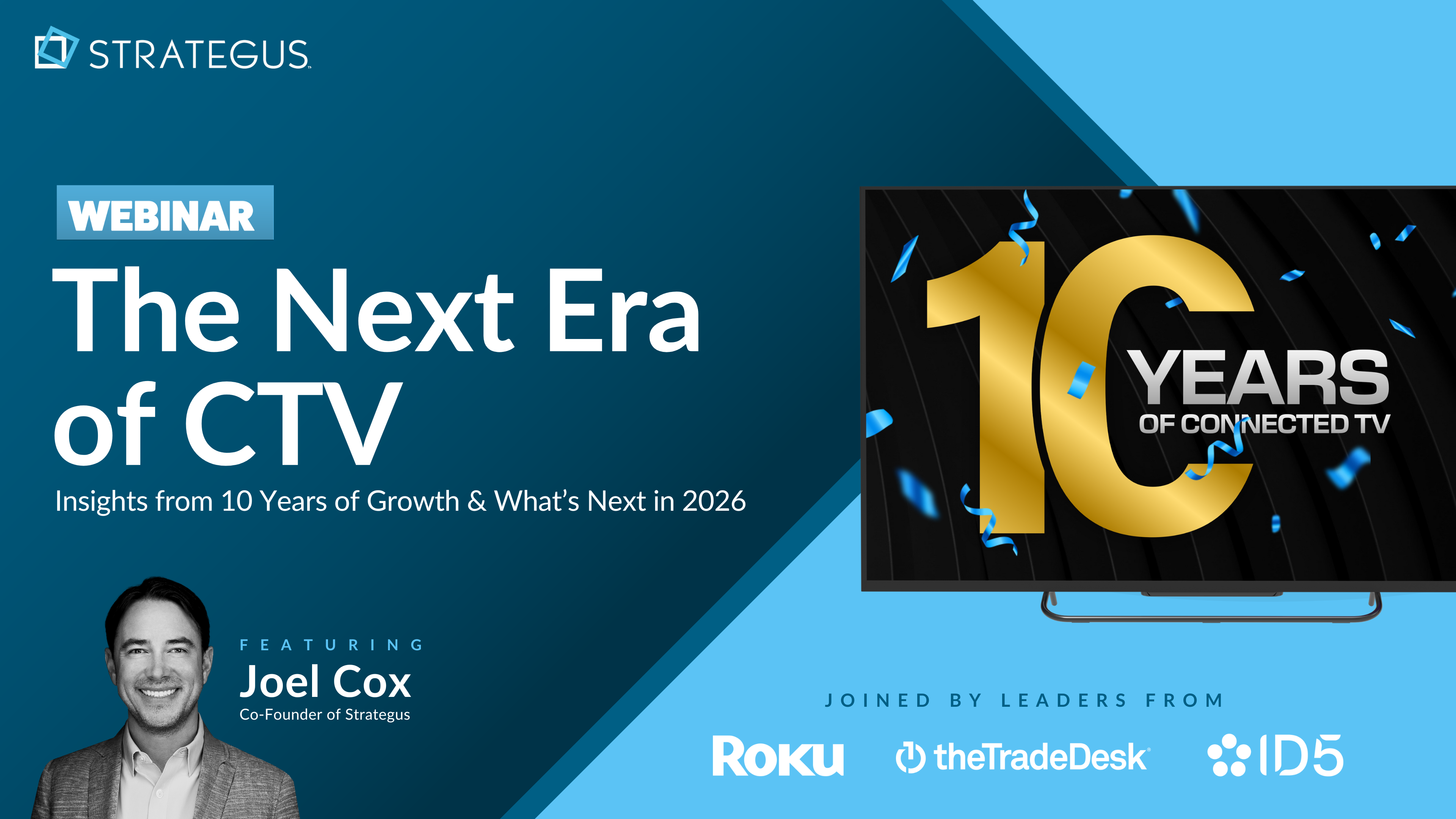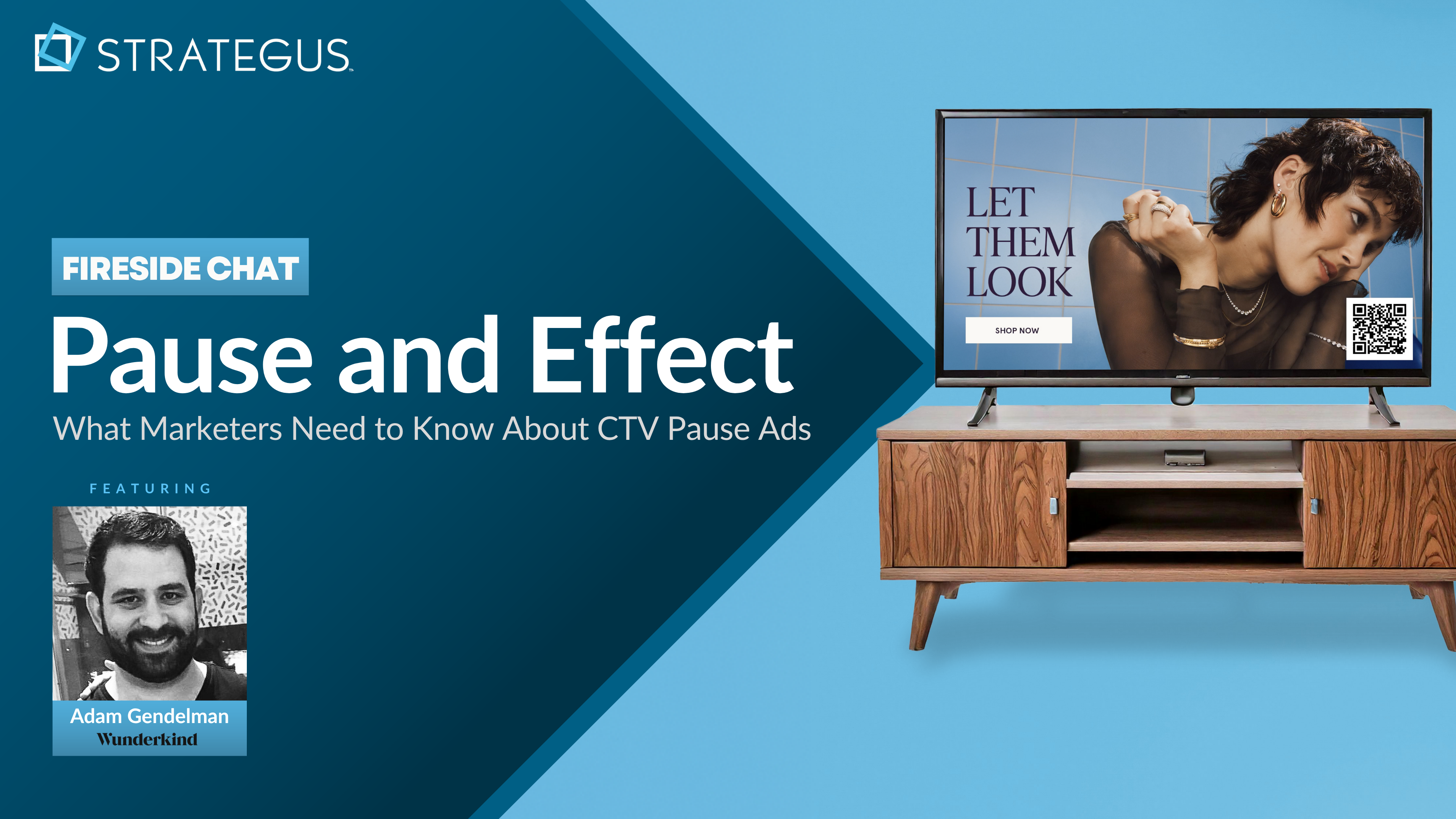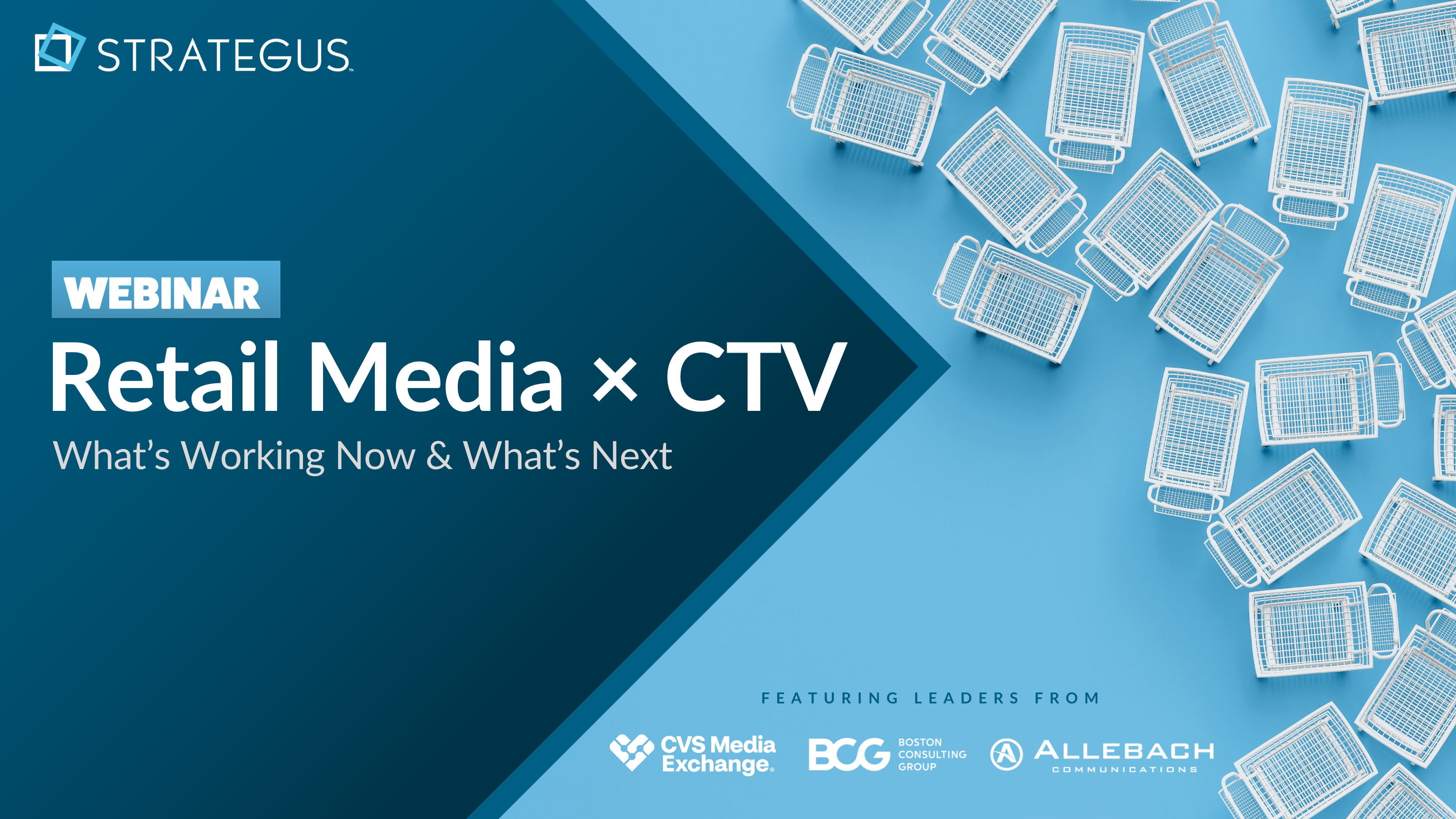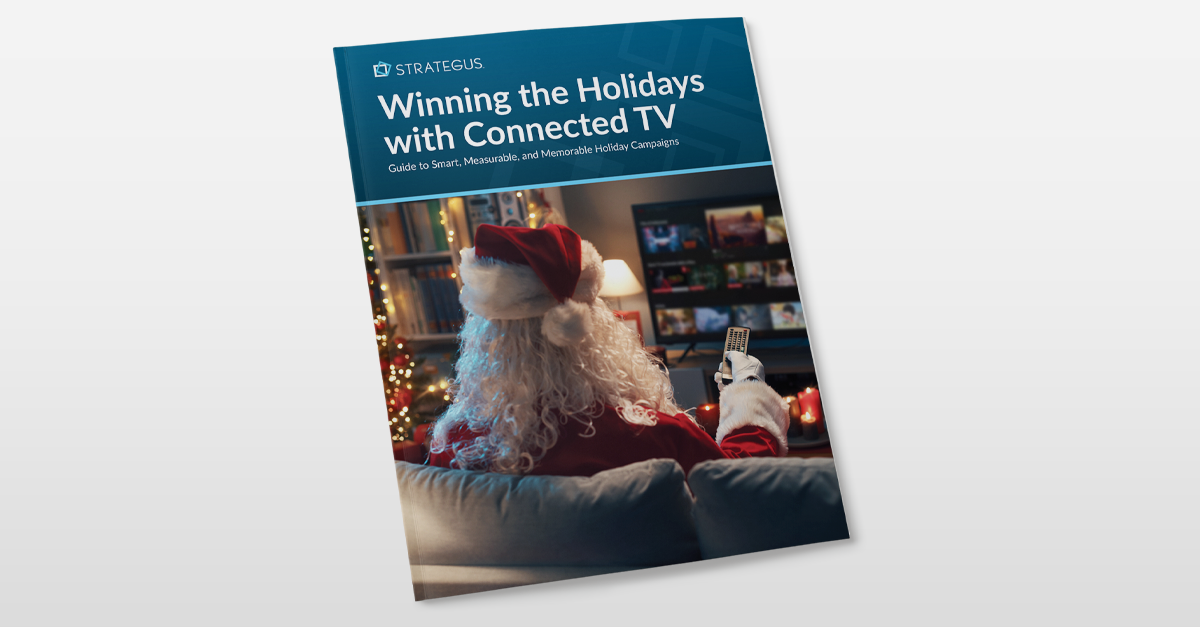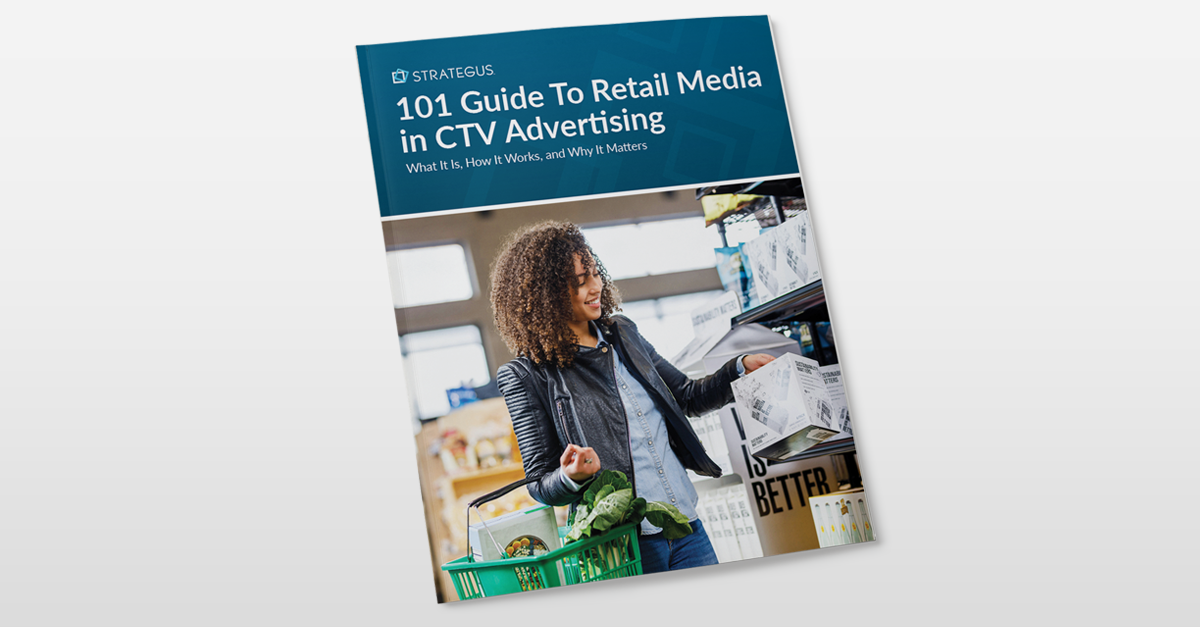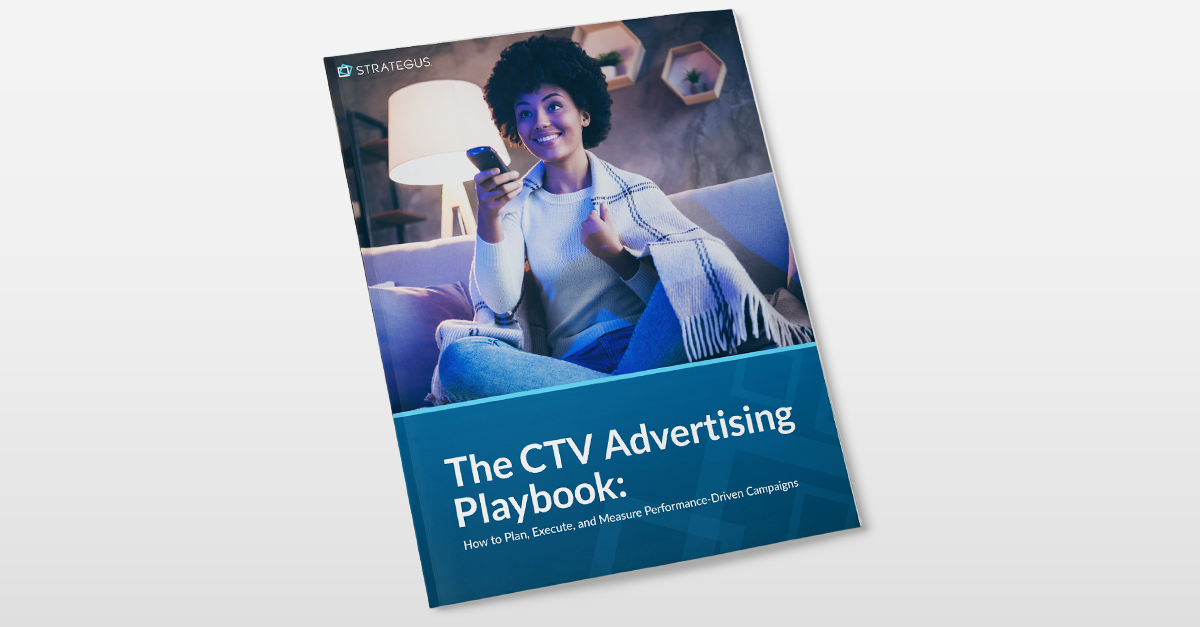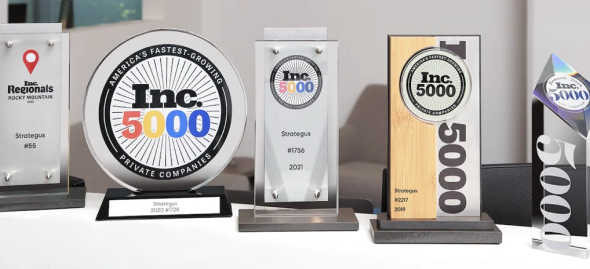- Home
- Strategus Blog
- Programmatic Advertising Strategy: A Complete 2025 Guide
Programmatic Advertising Strategy: A Complete 2025 Guide
 Andy Dixon
Andy Dixon
12 minutes read

Struggling to cut wasted ad spend or frustrated by campaigns that miss the right audience?
Programmatic advertising solves this by using real-time data to target, measure, and optimize with precision. With tactics like sequential messaging and audience engagement tracking, brands can shape journeys that convert.
Best of all, programmatic delivers stronger results than traditional media buying, especially across CTV and OTT.
Here’s why programmatic advertising should be a part of your strategy in 2025.
Key Takeaways
- Programmatic advertising automates data-driven ad buying across CTV, OTT, display, audio; 2025 emphasizes AI optimization, privacy-first targeting, and cookie-replacing identity solutions.
- Optimize step-by-step: set funnel-aligned KPIs, activate consented first-party data, build segments and lookalikes, test creatives, and adjust bids, targeting, and budgets in real time.
- Prevent waste with balanced reach and frequency caps; rotate creatives, refresh quarterly, and use sequential messaging to guide awareness, consideration, and conversion across devices.
- Measurement has to go beyond CTR. Use multi-touch attribution, track cross-device paths from CTV exposure to site actions, and reallocate budgets weekly based on verified contribution.
- Benefits include efficiency, precision targeting, omnichannel flexibility, real-time transparency, and scalability; 2025 trends: CTV/OTT dominance, AI-driven optimization, retail media signals, and privacy-first identity.
- Reduce fraud, protect brand safety, simplify platforms, and boost ROI with our expert management and attribution. Speak to a Strategus expert to design a programmatic campaign that works in 2025.
What Is Programmatic Advertising?
Programmatic advertising is the automated way of buying ads using data and technology. It works across many channels, including CTV, OTT, display, and audio, and removes the need for manual negotiations.
It matters now because audiences are spread across different devices and streaming platforms. Marketers need precise targeting to reach the right people without wasting budget.
In 2025, the big changes are smarter AI tools that optimize campaigns in real time, stronger focus on privacy-first targeting, and new identity solutions that replace cookies to keep ads relevant and accurate.
How to Optimize a Programmatic Campaign: Step-by-Step
Programmatic advertising works best when every decision is tied to clear goals and measurable outcomes. Here’s how to make your campaigns sharper, more efficient, and more profitable in 2025:
1. Define Clear KPIs
Start by identifying the primary goal of your campaign.
- Awareness: Track impressions, reach, video completion rate, and brand lift surveys.
- Consideration: Monitor clicks, engagement, landing page visits, and cost per completed view (CPCV).
- Conversions: Measure cost per acquisition (CPA), return on ad spend (ROAS), and leads generated.
Always align KPIs with business objectives. For example, a CTV campaign may prioritize video completions, while a retargeting display campaign focuses on conversions.
2. Use First-Party Data and Lookalikes
The popularity of third-party cookies are fading, with stricter privacy regulations, browser restrictions, and consumer demand for data control limiting their effectiveness. First-party data is now the backbone of targeting.
- Collect audience data from your CRM, email lists, app interactions, or loyalty programs.
- Build custom segments (e.g., recent purchasers, cart abandoners, high-LTV customers).
- Use lookalike modeling within your DSP to expand reach to audiences who share behaviors with your best customers.
3. Balance Reach vs. Frequency Caps
One of the biggest risks in programmatic is wasting budget by showing too many ads to the same people. This leads to ad fatigue, where audiences become bored or annoyed after seeing the same message repeatedly. Overexposure not only reduces engagement but can also damage brand perception and lower overall campaign performance. To prevent ad fatigue, make sure you:
- Set Frequency Caps: limit how often an individual sees your ad within a timeframe (e.g., 3 impressions per day, 10 per week).
- Keep an Eye on Frequency: Monitor frequency distribution in reporting dashboards to spot overexposed audiences.
- Add in Other Strategies to Offset Ad Fatigue: Balance caps with reach expansion tactics like using multiple creatives or extending to new platforms (CTV + mobile + desktop).
4. Use Sequential Messaging to Guide Journeys
Rather than serving the same ad repeatedly, design a narrative across touchpoints.
- Start with an awareness ad (short video introducing the brand).
- Follow up with a consideration ad (longer spot, testimonials, or product features).
- Retarget with conversion-focused creatives (offers, CTAs, sign-ups).
Sequential messaging works especially well in CTV, where households are highly engaged and messaging can be planned like a story arc.
5. Test Creative Variations and Optimize in Real Time
A strong strategy doesn’t stop at targeting, creative drives results.
- Test different ad lengths (15s vs. 30s), formats (video vs. interactive), and CTAs.
- Run A/B tests within your DSP to identify which assets click the most.
- Use performance signals (completion rate, CTR, engagement time) to pause underperforming ads quickly.
- Adapt creative based on audience segment (e.g., families vs. professionals see different messaging).
6. Apply Attribution to Link Spend to Outcomes
Attribution ensures you can prove which ads actually drive results. It connects ad exposure to real business outcomes like clicks, conversions, or sales. Without it, you risk guessing which parts of your campaign are working and wasting spend on tactics that don’t deliver.
- Move Beyond Last-Click Measurement: It undervalues awareness channels like CTV.
- Use Multi-Touch Attribution: Using MTA can help you learn about which touchpoints contribute to conversions.
- Track Cross-Device Impact: This can give you data about users who saw a CTV ad and later visited a website on mobile
- Use Attribution Insights to Reallocate Spend: For example, shifting more budget to channels or creatives proven to influence mid-funnel engagement.
Treat optimization as an ongoing process, not a one-time setup. Review performance data weekly, adjust targeting, refresh creatives, and test new segments. The compounding effect of small, continuous improvements often drives the biggest ROI gains.
Benefits of Programmatic Advertising

Here are some of the best advantages of programmatic advertising:
1. Efficiency
Programmatic advertising saves time by automating the ad buying process. Instead of negotiating deals manually, the system buys and places ads in real time. This automation reduces delays, lowers labor costs, and allows marketers to focus more on strategy and creative work.
2. Precision
With programmatic, every decision is driven by data. Marketers can target audiences based on demographics, interests, browsing behavior, and even real-time signals. This precision ensures ads reach the right people at the right moment, which improves relevance and return on investment.
3. Flexibility
Programmatic advertising works across many channels, including connected TV (CTV), mobile, desktop, digital out-of-home (DOOH), and audio. This flexibility allows brands to deliver a consistent message no matter where their audience spends time. It also makes it easy to adjust campaigns quickly when market conditions change.
4. Transparency
Marketers can see results as they happen. Real-time reporting shows where ads appear, who engages with them, and how each placement performs. This visibility helps advertisers track performance, control budgets, and make smarter adjustments during the campaign.
5. Scalability
Programmatic campaigns can run on a small local scale or expand to reach national audiences with equal ease. Marketers can start with limited budgets to test strategies and then scale up quickly once they find what works. This scalability makes programmatic ideal for both small businesses and global brands.
Attribution and Measurement in 2025
Attribution and measurement are extremely important for programmatic success in 2025. Marketers need to track the entire customer journey, connect actions across devices, and use real-time insights to refine campaigns while they run.

1. Beyond CTRs
Click-through rate (CTR) is no longer enough to judge success. In 2025, advertisers track deeper actions such as site visits, video completions, form fills, and purchases after ad exposure. These metrics show how audiences actually engage with a brand and give a better picture of campaign impact.
2. Multi-Touch Attribution
Customers often see multiple ads before making a decision. Multi-touch attribution connects these touchpoints across devices. For example, a viewer may see a CTV ad at home, later search on mobile, and finally buy on desktop. Measuring the entire path helps marketers understand which channels and messages drive conversions.
3. Real-Time Measurement
Programmatic platforms now provide live reporting. Advertisers can see what works and what fails while the campaign is still active. This real-time data makes it possible to adjust targeting, budgets, or creatives instantly instead of waiting until the campaign ends. It prevents wasted spend and improves overall performance.
4. Backend Insights
Detailed analytics on the backend do more than confirm results. They feed back into future strategy. For example, insights on which audience segment responded best can guide the next retargeting campaign. Creative performance data can shape which ad formats or messages to use moving forward. This loop makes each campaign smarter than the last.
Common Challenges and Fixes for Programmatic Ads
Programmatic advertising, while extremely effective, has some challenges that your advertising team or partnered agency will have to figure out. Here are some of the most common challenges of programmatic advertising:
1. Ad Fraud and Brand Safety
One major challenge in programmatic advertising is ad fraud. Fake impressions and invalid clicks waste budget and reduce trust. Unsafe placements can also hurt brand reputation. The fix is to work with supply-side platforms (SSPs) that use strong fraud detection tools and brand safety filters.
These tools block fake traffic, verify impressions, and make sure ads only appear in trusted environments.
2. Data Privacy Regulations
Privacy laws like GDPR and CCPA limit how marketers collect and use consumer data. This creates challenges for audience targeting. The best fix is to rely on first-party data collected directly from customers with their consent.
Brands can also use contextual targeting, where ads appear based on page content, and invest in privacy-compliant identity solutions.
3. Platform Complexity
Programmatic campaigns run through demand-side platforms (DSPs), which can feel overwhelming for many teams. Managing multiple settings, data integrations, and bidding strategies often requires expertise.
The fix is to work with managed DSPs or experienced providers. They handle technical tasks, reduce errors, and allow marketers to focus on campaign goals instead of platform mechanics.
4. Budget Waste from Poor Targeting
Overspending happens when ads reach the wrong audience or hit the same person too many times. This leads to wasted impressions and lower ROI. The fix is to set frequency caps that control how often a user sees an ad.
Key Trends Shaping Programmatic Advertising in 2025
Programmatic advertising is growing fast, and marketers need to follow the trends that shape how budgets are spent. The shift to streaming, the rise of AI, and stricter privacy rules are changing the way campaigns run in 2025.

1. CTV and OTT Dominance
Streaming has overtaken cable and broadcast as audiences continue to cut the cord. Just recently, streaming accounted for 34.8% of total TV consumption, ahead of traditional TV. Connected TV (CTV) is now the top choice for 3 out of 4 video buyers. With 79% of households spending the same or more time streaming, advertisers cannot afford to ignore CTV and OTT.
2. AI-Driven Optimization
Artificial intelligence is now central to programmatic campaigns. AI powers smarter bidding, audience targeting, and predictive analytics, which makes campaigns more efficient. Automation saves time and helps advertisers make real-time adjustments. While programmatic platforms handle the buying, they still require ad operations mastery to get the best results.
3. Retail Media and Commerce Data
Retail media networks and commerce-driven data are fueling programmatic growth. By activating shopper intent signals, advertisers can target audiences who are closer to making a purchase. This trend expands the role of programmatic from brand awareness to full-funnel performance.
4. Privacy-First Solutions
Cookies continue to fade, and data privacy laws are stronger than ever. Marketers are shifting to first-party data, contextual targeting, and identity-based solutions. The move to privacy-first strategies ensures compliance while still keeping campaigns relevant and effective.
5. Omnichannel Integration
Programmatic is no longer just about display ads. Campaigns now run across CTV, OTT, programmatic audio, mobile, desktop, and digital out-of-home (DOOH). This integration lets brands deliver consistent messaging across every channel. It also allows advertisers to reach audiences nationally or locally with equal precision.
6. A Programmatic Future
Programmatic is on track to dominate digital ad spend. Over 90% of all digital display ad dollars were already transacting programmatically in 2022, and that share continues to climb. In fact, more than 78% of CTV video ad spending was programmatic by 2023. Nearly 70% of advertisers say CTV/OTT allows local targeting in ways traditional TV never could. Advertising is moving toward a programmatic future defined by faster processes, efficient delivery, and bigger results.
Closing Thoughts — Partner With Strategus for Smarter Programmatic

Back in 2015, Strategus pioneered programmatic OTT/CTV advertising, and our team continues to lead the innovation today. Partnering with Strategus gives you more than access to technology; we give you expertise that turns complex data into clear results.
- Simplify programmatic ads with expert guidance.
- Get access to our advanced attribution suites that connect spend to outcomes.
- Activate first-party data seamlessly across CTV, mobile, audio, and desktop.
- Gain CTV-first strategies that deliver higher ROI and audience engagement.
As streaming overtakes traditional TV, Strategus helps you stay ahead of the shift with campaigns built to perform across every screen.
If you want tailored strategies, smarter optimization, and measurable results, we’re the partners that make it happen. Speak to a Strategus expert to learn more today.
Frequently Asked Questions
1. How to Optimize Programmatic Campaigns?
Start by setting clear KPIs that match your business goals. Use first-party data for precise targeting and lookalikes to expand reach. Apply frequency caps to avoid overexposure. Test creative variations and monitor performance in real time. Regularly adjust targeting, budget, and placements based on attribution insights to improve ROI.
2. How to Target My Programmatic Ads?
Targeting works best when you use first-party data from your CRM, website, or apps. Build audience segments like recent buyers, cart abandoners, or loyal customers. Use contextual targeting to place ads in relevant environments. Apply lookalike modeling to scale reach and add filters like location, demographics, and behavior for precision.
3. What Is Advertising Optimization?
Advertising optimization is the process of improving ad campaigns so they reach the right people at the right time with the right message. It includes adjusting targeting, testing creatives, managing frequency, and tracking results. The goal is to reduce wasted spend, increase engagement, and drive stronger business outcomes.
4. How Much Budget Do I Need to Start With Programmatic Advertising?
You don’t need a massive budget to begin. Many demand-side platforms (DSPs) allow campaigns starting from a few thousand dollars. Smaller advertisers often test with limited budgets to see results, then scale up once they identify winning strategies. The key is to set clear goals before spending.
5. Can Programmatic Advertising Work for Small or Local Businesses?
Yes. Programmatic is highly flexible and works for both local and national campaigns. Local businesses can target specific zip codes, neighborhoods, or even households on CTV and mobile. With proper frequency caps and audience filters, smaller budgets can still generate strong ROI.
6. How Do I Know If Programmatic Ads Are Really Working?
Success depends on tracking the right metrics. Go beyond clicks and impressions by measuring site visits, conversions, video completions, and post-ad actions. Attribution reports connect ad exposure to outcomes, such as sales or leads. Reviewing these metrics weekly helps confirm ROI and guide adjustments.
7. What Makes CTV and OTT So Important For Programmatic in 2025?
Streaming has now overtaken cable and broadcast in audience share, which makes CTV and OTT a must-buy. These platforms deliver highly engaged viewers and allow precise targeting at the household level. Advertisers can run sequential messaging and track results across devices, which is not possible with traditional TV.
8. Should I Manage Programmatic Campaigns Myself or Work With a Partner?
Programmatic platforms can feel complex, especially when managing multiple channels and attribution models. Working with a partner like Strategus gives you access to expert guidance, advanced attribution tools, and strategies built around CTV-first campaigns. A managed approach saves time, reduces wasted spend, and delivers better results.

Andy Dixon is a seasoned Content Writing Specialist at Strategus, renowned for his expertise in creating engaging and impactful digital content. With over a decade of experience in content creation, Andy has honed his skills in a variety of niches, ranging from technology and marketing to education.
Strategus is a managed services connected TV(CTV) advertising agency with over 60,000+ campaigns delivered. Find out how our experts can extend your team and drive the result that matter most.
Talk to an Expert
Seeking a Custom CTV Strategy That Delivers?
What to read next
App Event Tracking: Tie Mobile App Activity to CTV Campaigns
Let’s say you’re running a CTV campaign for a personal finance app.
5 minutes read

Stop Guessing Who Your Audience Is — Let Their Apps Tell You
Connected TV (CTV) targeting often falls in one of two camps.
8 minutes read
See Who Bought After Your Ad + How Much They Spent
You can’t improve what you can’t measure. And for years, that’s been a major problem with TV advertising.
4 minutes read
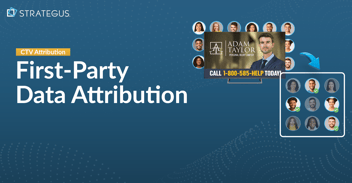
First-Party Attribution: Match Ads to Sales With CRM Data
The value of first-party data continues to grow.
7 minutes read

